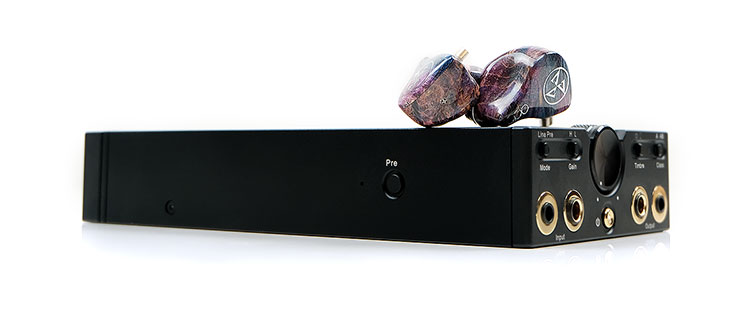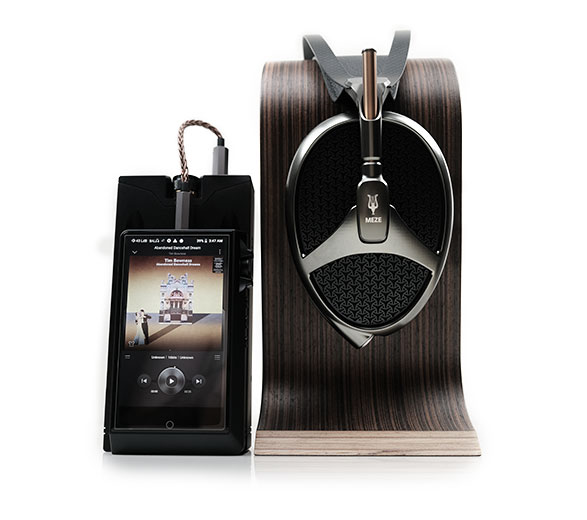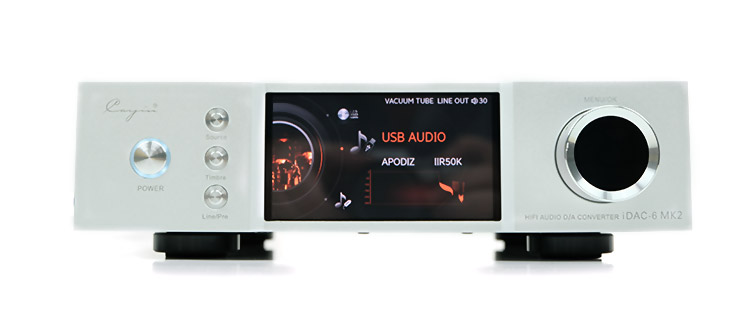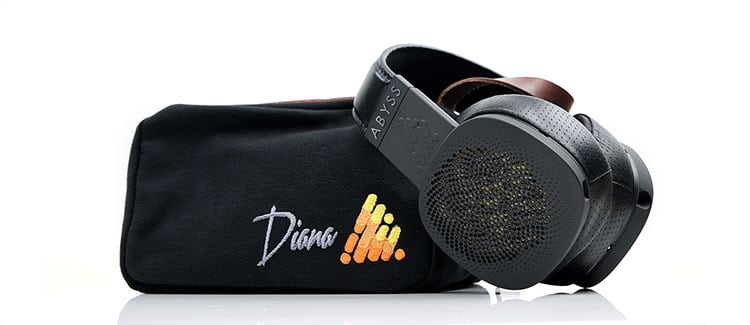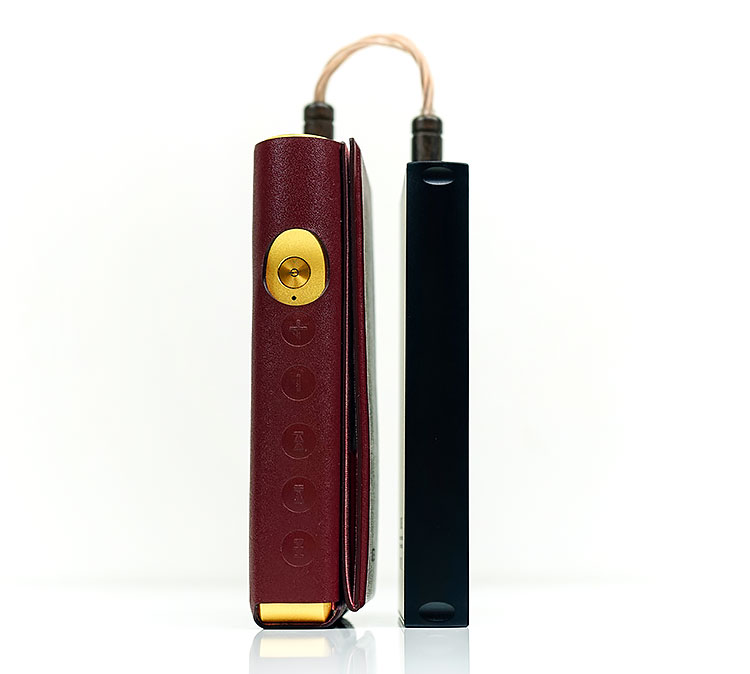Synergy
Efficiency
Noise
At least where portable tube headphone/IEM amplifiers are concerned, the Cayin C9 is the quietest iteration I have reviewed to date. Of course, there are limits.
Sensitive monitors such as the Andromeda 2020 and the Solaris will pick up a bit of hiss going balanced 4.4mm though, to be honest. So, going single-ended is more than enough for these two to sound excellent.
Single-ended at 700mw-1200mW from 32Ω down to 16Ω and tons of current is frankly overkill, so it is really the timbre you are after here and the very quiet noise floor.
For the Andromeda 2020, the tube option in Class A low-gain is where I would go over any of the solid-state modes. It brings in just the right amount of smoothness in the mids to tease out a very intoxicating vocal performance and well above average instrumental and vocal separation.
You could make an argument though for Class AB with the tube timbre for the Solaris. That dynamic driver soaks up the additional bass weight and punches very nicely and it is something I like to hear bring pushed harder with hybrid IEMs.
Dynamic Drivers
Where I would go full solid-state and Class AB is with something like the qdc Dmagic 3D which is a triple dynamic driver high-end monitor we just recently reviewed. Its SPL is also low-enough to avoid any hiss from going balanced which is how I preferred pairing it with the C9.
The Dmagic 3D is not a bass monster per so but rather is has plenty of vibrancy and an already rich and fulsome timbre from top to bottom from those dynamic drivers. The dynamic drivers pair beautifully with the power and energy of the C9 solid-state mode.
The only time I would consider going to the smoother Class A sound with the Dmagic 3D is when using the stock single bore tips which tend to tease out a bit too much treble energy for my liking.
Because of the C9’s excellent depth and sub-bass presence, I would recommend pairing it with the Empire Ears Odin as well as the Hero. Both monitors have killer dynamic driver low-ends, the Odin being the more detailed and controlled of the two.
The C9 does a heck of a lot better than alternative portable tube amps and even the Hugo 2 in terms of bringing out the detailed sub-bass texture and presence with these two.
I would, however, stay with Class AB using the Odin and switching to Class A with the Hero just to tame its highs a bit more. The loss of the sub-bass weight moving to Class A seems to rob the Odin of a bit of balance with its forward upper mids.
The Odin’s harmonic balance is actually very nice with the C9 tube timbre and Class AB. Just enough smoothness in the highs without upsetting the bass balance.
User Case for Power
With a rating of around 2.1W (4.1 on a 16Ω load), the C9 will actually be a very handy ‘bedfellow’ for most modern planars outside of the most demanding sub-90dB SPL rated Hifiman’s. For dynamic driver headphones, 150Ω to 300Ω at a stretch will be about right before you run out of headroom and dynamic range.
Given the price of the C9, you will always run into the question of whether a stronger desktop amp at the same price or less will be the right pairing in this scenario. However, there are some headphones that people do like to bring on the road or to the office with them that many DAP’s (outside of the HiBy R8 at a pinch) can find challenging.
Headphones such as the Dan Clark Audio AEON 2 or the Abyss Headphones Diana V2 are quite portable in nature and can often wind up at local meets. Headphones such as these are never completely at home on a DAP and for me, that is where the C9’s power and versatility come into their own.
DCA AEON 2
With the DCA AEON 2 Closed pairing, you have tons of headroom going balanced on the C9, even in low-gain. I hit about 12 noon on the pot for comfortable listening levels before dropping down to 11am on high gain. Either will work fine depending on your preference but low-gain will give you a bit more battery life.
All modes have excellent dynamic range and no question the AEON 2 has a good dynamic range performance from the C9, especially with the punchier AB. However, in terms of mixing and matching the modes, I preferred the Tube with Class AB or solid-state with Class A using the AEON 2.
The AEON 2 treble felt just a little on the harsh side with the solid-state Class AB mode of the C9. True, the bass was excellent, pacy, and full of PRaT but the upper mids and treble tended to clash a little more compared to the tube Class AB mode or the solid-state class A. I would rather trade a little bass weight in favor of a smooth vocal and top-end.
Abyss Headphones Diana V2
The Abyss Diana V2 can work quite well from the C9 though, for me, its most authoritative performance came with the C9 paired with the iDAC-6 MK2 in PRE-amp mode.
Here the headroom and solidity from the balanced XLR to 4.4mm input and using a 4.4mm output on the Diana v2 was very good and worthy of a high-end desktop performance.
Meze Empyrean
The best pairing was the Meze Empyrean. Not only in terms of driving capability but also the timbral matching. All DOA modes and timbre options sounded convincing with the Empyrean, it is just a question of preference. The amount of power is also perfect to tease out some excellent dynamic range and in the case of the 4.4mm balanced output, a healthy level of separation.
It is really the C9’s vocal presence that paired so well with the Empyrean. It is slightly forward, particularly so when going Class AB but never shouty or aggressive.
Staying with AB will also give you that punch further down so the Empyrean is not left lifeless or shallow sounding either. Class A is really more for quieter moments when you want a liquid timbre in combination with the tube timbre or ease back a bit on the bass from the Class AB signature.
PRE-Amp Mode
For this, we tested a few options, primarily desktop with Cayin’s own iDAC-6 MK2 DAC using its PRE-amp setting and analog outputs in conjunction with its iDAP-6 as the source.
We also tested with the Sony 1Z as our primary source and compared this also to the C9 to get some idea of just how much of the 1Z signature is colored between using C9 PRE-amp.
Setup
There are a few steps to activate PRE-amp just to ensure you do not blow your ears out with the additional power. You do need to have the pre-amp output set on the DAC as the volume will be controlled there rather than on the C9.
You also need to set your C9 volume to zero as it will revert to line out if you break the connection so again, another safety measure. The final step is when everything is plugged in, including your headphones, switch the mode from line-in to PRE-amp by pressing and holding the PRE button on the left panel for 3 seconds to activate it.
Cayin iDAC-6 MK2
Comparing line-out to a PRE-amp can be a bit tricky as you have to weigh in the influence of the DAC of whatever varying sources you have also as they bring a bit of color to the table also.
The Cayin N6ii/E02 uses a dual ES9038Q2M compared to the iDAC-6 MK2’s single ES9028PRO. Different chips but of the same family of chips renowned for being fairly transparent and clean sounding.
Cayin has never really accepted that sound as fixed and true enough, going back to the older N5ii DAP right up to the E01 and E02 motherboards, they have managed to produce a very different tone to what you would expect from a Sabre chip.
As a result, I find both the E02 and the iDAC-6 MK2 to be natural sounding outputs with good bass response, nice warmth, and excellent separation.
Dynamic Range
Still, there is a difference, even when plugged into the C9 using PRE-amp versus line-out on the E02. You always feel the PRE-amp/iDAC-6 MK2 headroom has plenty to give, much more so than the E02 with a bit more dynamic range and a very immediate and engaging midrange.
Particularly so when both the C9 and the iDAC-6 MK2 are in the transistor or solid-state mode and the C9 is in Class AB. Vocals sound solid on the E02 but the stock coloration of the iDAC-6 MK2 pre-amp output is meatier through the mids, more powerful on the low-end, and a shade more holographic also in staging.
Timbre
Another bonus is the iDAC-6 MK2 transistor and vacuum mode. You can easily pick them out on the C9 PRE-amp mode and their differences. That gives you a ton of coloring options aside from what is already available on the C9.
The iDAC-6 MK2 transistor mode is punchier, more immediate, and energetic sounding. It also sounds like the gain level is 1-2dB higher on the C9 using the Empyrean as our test headphones. The Vacuum mode is more relaxed sounding, creamier in its timbre, and not quite as intimate in its presentation.
You can bring a bit of ‘bass bounce’ and depth back into the iDAC-6 MK2 vacuum mode by option for Class AB on the C9 which the punchier sounding of the 2 DOA options. Or you can opt for Transistor mode on the PRE-out and solid-state Class AB on the C9 for maximum punch and power.
You can double down on the ‘cream’ so to speak by going back to Class A and switching both the C9 and the iDAC-6 MK2 to their respective tube modes.
This combo is incredibly sweet and smooth, particularly for vocals with the Meze Empyrean. The Empyrean is a headphone that always pairs nicely with rich sounding vocal performances though the bass weight is sliced away a shade. Just be prepared to up the volume by 1-2 steps because it does sound a little attenuated compared to its transistor equivalent.
Headphone Pairings
The initial Empyrean pairing felt well under control with the iDAC-6 MK2 and the C9 in PRE-amp mode. Of course, the Empyrean is fairly easy to drive for a planar headphone but even something like the Abyss Headphones Diana V2 paired very well with this setup.
I would not suggest chucking out your dedicated desktop amps since the Diana V2 can really scale. However, the IDAC-6 MK2 pre-amp headroom was very comfortable in the mid-zone for volume with the Diana V2 using the C9’s balanced output.
Combined with the C9/iDAC-6 MK2’s tube timbre and Class AB on the C9 you get a very smooth delivery and more than decent but well-defined bass weight.
Switching to the transistor mode on the iDAC-6 MK2 and C9 will tease out a bit more treble but also a more dynamic sounding bass/mid-range performance. The timbre is cooler, less forgiving especially with a lot of treble overtones. My own personal preference is tubes and Class A with the Diana V2 with this setup.
Sony NW-WM1Z
The 1Z has been a long-stay DAP in my collection but lacks a dedicated line-out. Instead, it uses a fairly weak PO only amplification stage, normally only useful for IEMs. It does though have a very nice and smooth, if slightly bass-weighted, sound that has garnered many fans, including me.
Amplification to date, with a focus on Sony, has been few and far between so the question is, using PRE on the C9, just how close can we get to the classic 1Z sound to bring a wider range of headphones into the equation? (note, for comparison with the BA300S in the picture above please click on page 3 for select comparisons).
Headphones Pairings
Meze Empyrean
The C9 will certainly bring in the possibility to pair headphones with the Sony as your source, (and PRE-amp). With the Empyrean using the Sony and the C9 on high gain, we had a very comfortable volume setting of around 70-75 so headroom for this moderate planer is not so much of an issue.
Certainly, without the C9 this pairing would not be possible and definitely a step up in dynamic range and clarity from the BA300S which I have used previously with the 1Z. The BA300S has some beautiful creamy rich vocal performances but it lacks a lot of sub-bass and upper treble extension compared to the C9 pairing.
WIth the DSEE HX and vinyl processor on, the Empyrean sounds very punchy actually with some very clear vocal performances with the solid-state and Class AB on the C9.
However, I do detect a little bit of harmonic dissonance on the upper mids with this timbre and class which can lead to some very hard attacks on vocals and percussion. I much prefer the tube timbre and Class A with this combo to introduce a more liquid harmonic balance to the same timbre.
Abyss Headphones Diana V2
The Abyss Diana V2 also has enough headroom using high gain on the C9 and the Sony 1Z (95 steps) so demanding headphones are not out of reach. Is it optimal? No, I would hesitate to give a full thumbs up here as the Diana V2 has a lot more low-end to offer on a stronger desktop amplifier.
However, by stronger I mean a smoother sounding 3-4W plus desktop, and plenty of desktops are not as powerful as the C9 considering Diana’s V2 42Ω rating.
At times I actually prefer the Diana V2 over the Empyrean with this pairing simply because I prefer to use the Empyrean for richer vocals. The Sony vocal performances are smooth but not overly rich which seems to suit the Diana V2 a bit better with its stronger treble extension and airier top-end.
Click on page 1 below for tech inside, design, and I/O rundown
Click on Page 2 below for performance numbers & sound impressions
Click on page 4 below for select comparisons


